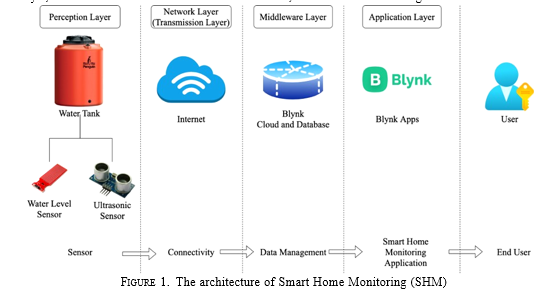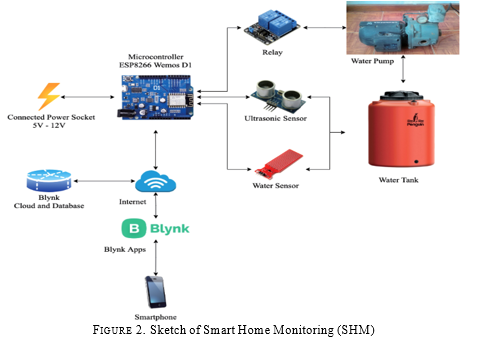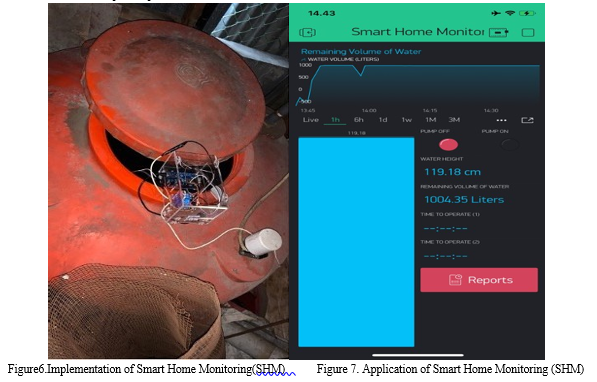Ijraset Journal For Research in Applied Science and Engineering Technology
- Home / Ijraset
- On This Page
- Abstract
- Introduction
- Conclusion
- References
- Copyright
The Implementation of Smart Home Monitoring Systems for Real-Time Water Level Measurement, in Combination with the Internet of Things (IoT), presents a Potential Pathway for Attaining Energy Efficiency in the Realm of Electricity Consumption
Authors: Dr. A. Gowthaman, Er. K. Arulmozhi
DOI Link: https://doi.org/10.22214/ijraset.2023.55849
Certificate: View Certificate
Abstract
Water pumps play a crucial role in facilitating the provision of water for various domestic activities. Nevertheless, the energy consumption necessary for its operation is substantial. Prior studies have investigated the implementation of an automation system utilizing an Arduino microcontroller to conserve electrical energy in a water pump. This system was designed for the purpose of automating plant watering and incorporated ultrasonic sensors to mitigate the risk of overfilling. The present study introduces an affordable Smart Home Monitoring (SHM) system. The current automation system can be enhanced through the incorporation of a water sensor. This addition aims to mitigate the occurrence of vacuum and excessive water in the tank, which arises from imprecise water level calculations conducted by the ultrasonic sensor. Furthermore, this study aims to implement an automated water filling system, which allows users to conveniently monitor the remaining water level in real-time through smartphones utilizing the Internet of Things (IoT) technology. Notably, this approach has not been previously explored by researchers. The assessment of energy conservation achieved through the utilization of a water pump is determined to be 39.2% when employing Smart Home Monitoring (SHM) technology.
Introduction
I. INTRODUCTION
Presently, electrical energy is a highly essential and extensively utilized form of power, particularly in the context of electronic devices. Computers, washing machines, rice cookers, and water pumps are extensively utilized and necessitate a substantial quantity of electrical power [1]. Nevertheless, the utilization of electronic devices is directly proportional to the consumption of electricity, leading to a substantial escalation in the corresponding electricity expenses. Hence, it is imperative to establish a method for conserving electrical energy consumption to mitigate the escalating financial implications. This objective can be accomplished through either enhancing energy efficiency or decreasing the level of service consumption. The conservation of electrical power is a prevalent area of research that is extensively pursued. Prior studies have explored the concept of conserving electrical energy through the creation of an Energy Management System (EMS) that utilizes the Internet of Things (IoT). This system has been successfully implemented in the Project Circuit Board (PCB) [2]. The Energy Management System (EMS) was developed with the purpose of monitoring energy consumption through a web-based interface. Additionally, users are able to remotely control ON/OFF devices that are not currently in use by utilizing the Internet.
The water pump is an electronic device that consumes a significant amount of electrical power. The significance of the water pump lies in its function of providing water for various daily activities. During its initial operation, the water pump consumes a significant amount of electrical power. If the pump is not functioning efficiently, it is likely that there will be an increase in the electricity bill. Various techniques are employed to achieve energy efficiency in water pumps, including the utilization of a water tank [3] and the implementation of the soft starter method, which involves operating an electric motor at a reduced current setting [4]. Moreover, empirical evidence has demonstrated that the utilization of an inverter is effective in reducing power consumption in water pumps [5]. The rapid development of technology has been instrumental in enhancing the efficiency of various activities [6,7].
The microcontroller is a widely utilized instrument for the measurement of surrounding data. The microcontroller is engineered to function in a manner analogous to the human brain. The Arduino microcontroller is a versatile device capable of receiving input, executing programmed instructions, and generating outputs as required [8]. These outputs may include measurements of air [9] and soil moisture [10], among other possibilities. One of the existing technologies involves the utilization of an automation system that employs a microcontroller for the purpose of automatically regulating the water pump [11]. The employment of a microcontroller, exemplified by the Arduino, can facilitate the flexible operation of a system [12]. For instance, the automation of plant irrigation can be achieved by integrating a soil moisture sensor with a water pump, which is programmed to activate based on predetermined conditions [13]. In addition to the development of the automation system for the water pump, Arduino is utilized to program the pump to cease operation upon tank saturation, thereby conserving electrical energy consumption. Previous studies have exclusively employed ultrasonic sensors to gauge the water level within the tank, as indicated by the sensor's placement [8]. Presently, the advancements in technology pertaining to the Internet of Things (IoT) have emerged as a significant prospect for consumers. The perceived advantages of Internet of Things (IoT) networks have incentivized consumers to engage in greater interaction with this technology [14]. The Internet of Things (IoT) is a network infrastructure that facilitates the provision of intelligent services by establishing connections between various objects and individuals via the Internet. This enables the development of an interconnected intelligent system, encompassing domains such as smart cities, smart agriculture, smart transportation, and smart manufacturing [15].
This paper aims to provide a comprehensive description of the architectural design, schematic representation, and implementation process of a Smart Home Monitoring (SHM) system. The system is specifically designed to leverage the capabilities of the Internet of Things (IoT) in order to accurately measure water levels, with the ultimate goal of optimizing electrical energy consumption in water pumps. The technology employed in this study involves the utilization of the Wemos D1 microcontroller, which has been integrated with a sensor for the purpose of measuring both the height and the remaining water level within the tank.
The ESP8266 is a widely used and popular microcontroller module that is commonly utilized in The Wemos D1 board is utilized as a substitute for the GSM module and Arduino [11,12], enabling the microcontroller to transmit data via a Wi-Fi network. In contrast to the transmission of data through Short Message Service (SMS), the current Internet infrastructure offers a higher degree of reliability.
Furthermore, in order to address the issue of inaccurately measuring the distance on the ultrasonic sensor at a range of 2 cm, we implemented the inclusion of a water sensor as a means of monitoring the remaining water level within the tank. The user will be provided with the data acquired by the sensor through a smartphone application. The ongoing development aims to create a system that enables real-time monitoring of water levels, volume, and pump status. Users will have the ability to access this information through a smartphone interface. The incorporation of Internet of Things (IoT) technology has led to the enhancement of physical environments, resulting in increased intelligence and interconnectedness.
The present paper is structured into four discrete sections. In the first section, an exposition is provided regarding the contextual framework and impetus behind the research undertaken. Subsequently, execute the suggested approach as outlined in Section 2. Following the elucidation of the proposed methodology, an empirical investigation is undertaken, as detailed in Section 3. Lastly, Section 4 presents a conclusion derived from the conducted experiment.
II. PROPOSED METHOD
The water pump is an electronic device that consumes a significant amount of electrical energy. During its initial operation, the water pump consumes a significant amount of electrical power. If the pump is not functioning efficiently, there will be an anticipated increase in the electricity bill.
Drawing upon prior research conducted on the topic of conserving electrical energy in water pumps. Ultrasonic sensors are a dependable means of measuring the distance between an object and the sensor. However, it has been discovered that the ultrasonic sensor possesses a vulnerability in accurately measuring a specific distance, resulting in a decreased level of precision when measuring the water level in the tank. The system exhibits a discrepancy of 2 cm in its ability to regulate the water level [16]. In order to address the limitations of the ultrasonic sensor, it is proposed to augment the sensor system by incorporating additional sensors.
This approach aims to facilitate collaborative functioning of the existing sensors, thereby enabling accurate measurement of the remaining water level within the tank.
III. THE ARCHITECTURE OF SMART HOME MONITORING
Figure 1 illustrates the architecture of this Smart Home Monitoring (SHM), which consists of the following four layers: perception, network, middleware, and application. Each of these layers is responsible for a specific set of responsibilities and functions. In the perception layer, there are two sensors: one detects ultrasonic waves, and the other detects changes in the water level.

sensor that is tasked with detecting and measuring the amount of water that is available. After the data has been obtained from these sensors, it is then sent by the network layer over the Internet network and stored in the middleware layer by the network layer. The application layer is responsible for facilitating communication between the user and the middleware layer once the data has been successfully stored in the middleware layer. The application layer caters to the requirements of the user, allowing subsequent users to more easily retrieve the information they require from the middleware layer. The data that the user obtains is presented in the form of the amount of water that is still present in the water tank. In addition, users can check the status of the water pump on their smartphone to determine whether it is operating or not.
IV. SKETCH OF SMART HOME MONITORING
Figure 2 presents a summary of smart home monitoring (SHM), which can be found in the internet. In this investigation, the Wemos D1 microcontroller serves as the system's controller when it comes to the Internet of Things (IoT)-based electrical energy saving system that was developed.
The water tank will be equipped with two sensors, namely an ultrasonic sensor and a water level sensor. These sensors will have the responsibility of measuring the amount of water that is still present in the tank and providing a minimum and maximum limit for the water pump to operate within.
When the water pump is operating, the sensors that are currently installed will continue to carry out their monitoring duties up until the predetermined maximum water level. After that, the sensor will send the data to the Wemos D1 microcontroller if it detects the water level according to the predetermined target. If it does not, the sensor will not send the data. After that, the information is transferred to the cloud and database that Blynk provides.
When the predetermined level of water has been attained, the Wemos D1 microcontroller takes control of the relay and instructs it to turn off the electric current that is being supplied to the water pump. This causes the pump to become inoperable. The user can view the remaining water level data that is stored in the Blynk cloud and database in real time by using the mobile application that has been developed. The remaining water level in the tank will be monitored by the sensor that is located inside the tank. Imagine that there is significantly less water than the required amount of water left. In such a scenario, the sensor will transmit the data to the Wemos D1 microcontroller, and the pump will start operating immediately in order to refill the water tank.
V. FLOWCHART OF SMART HOME MONITORING
Figure 3 is a flowchart that explains how the system that was created will monitor in real time and provide a condition in which the water pump will shut off automatically if there is no more water left in the tank. This condition is shown in the figure. After the pump has been turned off, the sensor will continue to perform continuous monitoring until it identifies a remaining water level of less than or equal to thirty percent. If the water level is less than 30 percent either at 5 a.m. or 5 p.m.,

PM, the water pump will begin its cycle of operation. However, outside of the hours of 5 a.m. and 5 p.m., the water pump will only operate if there is less than or equal to 20% of the water left.
The majority of teaching and learning activities that take place in schools around the world begin at seven in the morning local time. Even in major metropolitan areas, the school day begins at 6:30 in the morning. In addition, the majority of the employees reported for duty at seven in the morning. As a result, the appropriate time for the water pump to start operating is decided to be five in the morning so that users will not be left without water in the morning. In the meantime, the time of five o'clock in the afternoon has been selected because, at that point in time, the amount of water that is still available will have decreased due to the activities that were carried out from morning until noon, such as washing and cooking. The majority of the workers also wrap up their shifts at 5 o'clock in the evening. It is estimated that these workers require somewhere between one and two hours before they will be able to go home and immediately take a shower. Because the pump begins operating at five in the afternoon, users do not have to wait until the tank is completely full before using it because they do not have to wait for the pump to refill it. Naturally, this will also ensure that users do not go without the necessary amount of water.
VI. EXPERIMENT RESULTS
A simulation comparing the use of resources and the costs required to operate a water pump has been carried out by us. The simulation is run for a total of one month and a week. The first week is spent determining the power consumption and overall cost of water pumps that do not use the method that is currently being proposed. After a week has passed, an investigation into the proposed method is carried out to determine the cost of the power usage. In the simulations, a water pump, a water tank, and various tools to support Smart Home Monitoring (SHM) are utilized. These tools include an ESP8266 Wemos D1 microcontroller, ultrasonic sensors, water sensors, relays, power meters, and smart phones that are utilized to monitor remaining water levels. According to the findings of this study, the cost of electrical energy per 1 KWh costs 1,445.00 IDR per unit. Table 1 contains an evaluation table that breaks down the costs of using the necessary amount of power.

The Smart Home Monitoring (SHM) system resulted in a 39.2% reduction in the amount of electrical energy required to power the water pump during the experiments that lasted for two weeks and each consisted of two separate experiments. This is due to the fact that the water pump that is utilized in the proposed method is designed to work in conditions in which the amount of water that is still present in the tank is less than 20% of the total amount of water that is present in the tank. Additionally, the automation system has the capability of activating the water pump at predetermined times. The water pump is also given the conditions to operate properly in this experiment.

function if the amount of water that is left is less than 30 percent and the time is 5 in the morning and 5 in the evening. This is because, during that time of year, the demand for water for purposes such as bathing and other necessities tends to be higher. Figures 4 and 5 both contain graphs of the experiment's results, which you can see by referring to those figures.
Figure 6 depicts the application of this research, and Figure 7 demonstrates the use of smart home monitoring (SHM). Both of these figures can be found in the appendices. In Table 1, it is shown that the results of the use of electrical energy at the water pump for a week is 16 hours 17 minutes with a total cost of electrical energy incurred of Rupees.200.803 and the use of a water pump added with Smart Home Monitoring (SHM), the water pump only works for 12 hours 24 minutes and costs Rupees.116.571.
The ultrasonic sensor accuracy errors that were found in earlier studies can now be fixed thanks to the newly developed system, which makes use of two sensors at the same time. On the other hand, this research makes use of Internet of Things devices that are both cost-effective and simple to operate.

The water pump is equipped with an automatic operation mode, which ensures that the most efficient amount of power is consumed. In addition to that, the operational status of the water pump can also be monitored through the use of a smartphone. It is possible to obtain monitoring in real time directly from the Internet, which makes it possible for the system to function more accurately when measuring the amount of water in the tank. In previous research pertaining to energy savings, the inverter, the soft starter, and various scheduling methods were the primary foci. In contrast, the water pump was converted into an automation system in this research project using Smart Home Monitoring (SHM). In addition to being able to carry out monitoring in real time, the use of the water pump can also have its consumption reduced. When compared to the water pump system that did not use SHM, the experiments that were carried out using Smart Home Monitoring (SHM) resulted in a savings of electrical energy in the water pump that was at least 39.2% lower than the previous level. In addition to the benefits that were outlined earlier, this investigation does have a few drawbacks. For instance, the ESP8266 Wemos D1 module does not have an adequate level of stability when a program is loaded onto it, and the Blynk application needs to be connected to the internet in order to function properly. Because the Smart Home Monitoring (SHM) unit is installed on top of the tank, there must be an Internet connection that can reach the area where the water tank is located for it to function properly.
Conclusion
The ever-increasing consumption of electrical power in commercial and residential settings, which accounts for the vast majority of all electronic products sold, served as the impetus for this particular line of investigation. This article outlines a method for reducing the amount of electrical energy consumed by water pumps through the implementation of an efficient and cost-effective smart home monitoring system that is based on the Internet of Things (IoT). The innovation and development of what is known as the Internet of Things (IoT) have been progressing at a breakneck pace. The automatic monitoring system\'s primary objective is to improve both the efficacy and efficiency of energy consumption as a form of optimization. It is able to perform daily energy consumption analyses, which is the initial step in activities designed to save energy. When compared to Arduino, the ESP8266 Wemos D1 module supports Wi-Fi networks, which makes it ideal for use in the development of the Smart Home Monitoring (SHM) system. On the other hand, the ESP8266 Wemos D1 is a microcomputer that is simpler to operate and is significantly less expensive than the Raspberry Pi. In addition, the system is intended to function by employing a number of sensors to keep track of the amount of water that is still present and to create particular conditions in order to ensure that the pump is able to function at its most efficient level, thereby reducing the amount of electrical energy that is wasted. In the not too distant future, an application that is based on the Internet of Things (IoT) and Smart Home Monitoring (SHM) will be developed. This application will have a higher level of stability.
References
[1] S. Alani, S. N. Mahmood, S. Z. Attaallah, H. S. Mhmood, Z. A. Khudhur and A. A. Dhannoon, IoT based implemented comparison analysis of two well-known network platforms for smart home automation, Int. J. Electr. Comput. Eng., vol.11, no.1, pp.442-450, DOI: 10.11591/ijece.v11i1, 2021. [2] S. A. Hashmi, C. F. Ali and S. Zafar, Internet of Things and cloud computing-based energy man- agement system for demand side management in smart grid, Int. J. Energy Res., vol.45, no.1, pp.1007-1022, DOI: 10.1002/er.6141, 2021. [3] A. Kapanski, N. Hruntovich, S. Bakhur, L. Markaryants and L. Dolomanyak, Optimize the cost of paying for electricity in the water supply system by using accumulating tanks, E3S Web of Conferences, vol.178, DOI: 10.1051/e3sconf/202017801065, 2020. [4] A. Junaidi and S. Damayanti, Analysis of the e?ectiveness of using the soft starter method at the initial start on the operation of a 220 kW motor (Analisis efekti?tas penggunaan metode soft starter saat start awal pada pengoperasian motor 220 kW), Energi & Kelistrikan, vol.11, no.2, pp.55-65, DOI: 10.33322/energi.v11i2.559, 2019. [5] Atmam, E. Zondra and Zulfahri, Analysis of the use of electrical energy in a single phase induction motor using an inverter (Analisis penggunaan energi listrik pada motor induksi satu phasa dengan menggunakan inverter), SainETIn, vol.1, no.2, pp.1-8, DOI: 10.31849/sainetin.v1i2.207, 2017. [6] K. Zhou, T. Liu and L. Zhou, Industry 4.0: Towards future industrial opportunities and chal- lenges, 2015 12th Int. Conf. Fuzzy Syst. Knowl. Discov. (FSKD2015), pp.2147-2152, DOI: 10.1109/ FSKD.2015.7382284, 2016. [7] J. H. Nord, A. Koohang and J. Paliszkiewicz, The Internet of Things: Review and theoretical framework, Expert Syst. Appl., vol.133, pp.97-108, DOI: 10.1016/j.eswa.2019.05.014, 2019. [8] E. C. Prima, S. S. Munifaha, R. Salam, M. H. Aziz and A. T. Suryani, Automatic water tank ?lling system controlled using ArduinoTM based sensor for home application, Procedia Eng., vol.170, pp.373-377, DOI: 10.1016/j.proeng.2017.03.060, 2017. [9] S. Katangle, M. Kharade, S. B. Deosarkar, G. M. Kale and S. L. Nalbalwar, Smart home automation- cum agriculture system, 2020 International Conference on Industry 4.0 Technology (I4Tech2020), pp.121-125, DOI: 10.1109/I4Tech48345.2020.9102688, 2020. [10] F. Kamaruddin, N. N. N. A. Malik, N. A. Murad, N. M. azzah A. Lati?, S. K. S. Yusof and S. A. Hamzah, IoT-based intelligent irrigation management and monitoring system using Arduino, Telkomnika (Telecommunication Comput. Electron. Control.), vol.17, no.5, pp.2378-2388, DOI: 10. 12928/TELKOMNIKA.v17i5.12818, 2019. [11] A. Tadke, A. Kinage, A. Kulkarni, A. Khot, V. Chikkareddi and L. Ragha, Smart pump control system for optimal distribution of electricity, Proc. of the 2nd International Conference on Inventive Systems and Control (ICISC2018), pp.1103-1107, DOI: 10.1109/ICISC.2018.8398975, 2018. [12] Y. Hashim and M. N. Shakib, Automatic control system of highway lights, Telkomnika (Telecommu- nication Comput. Electron. Control.), vol.18, no.6, pp.3123-3129, DOI: 10.12928/TELKOMNIKA. v18i6.16497, 2020. [13] J. M. S. Waworundeng, N. C. Suseno and R. R. Y. Manaha, Automatic watering system for plants with IoT monitoring and noti?cation, CogITo Smart J., vol.4, no.2, DOI: 10.31154/cogito.v4i2.138. 316-326, 2019. [14] S. N. N. Htun, T. T. Zin and P. Tin, Consumer behavior analyzer in Internet of Things (IoT) environments, International Journal of Innovative Computing, Information and Control, vol.17, no.1, pp.345-353, 2021. [15] Y. Duan, H. Ni, X. Zhu and X. Wang, Reliable broadcast for WiFi-based Internet of Things through multi-access edge-dynamic FEC adaptation, International Journal of Innovative Computing, Infor- mation and Control, vol.16, no.5, pp.1739-1755, 2020. [16] S. Sachio, A. Noertjahyana and R. Lim, IoT based water level control system, 2018 3rd Technology Innovation Management and Engineering Science International Conference (TIMES-iCON), DOI: 10.1109/TIMES-iCON.2018.8621630, 2018.
Copyright
Copyright © 2023 Dr. A. Gowthaman, Er. K. Arulmozhi. This is an open access article distributed under the Creative Commons Attribution License, which permits unrestricted use, distribution, and reproduction in any medium, provided the original work is properly cited.

Download Paper
Paper Id : IJRASET55849
Publish Date : 2023-09-24
ISSN : 2321-9653
Publisher Name : IJRASET
DOI Link : Click Here
 Submit Paper Online
Submit Paper Online

